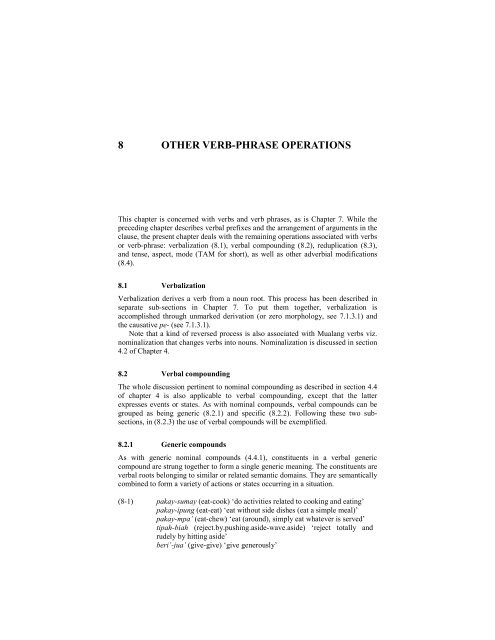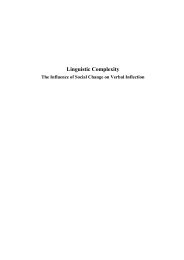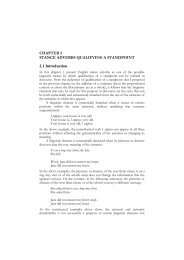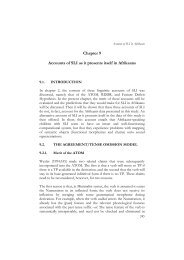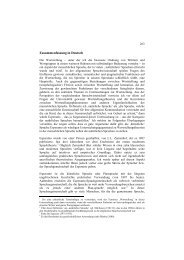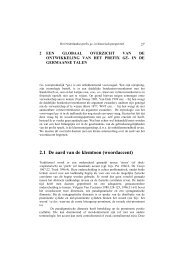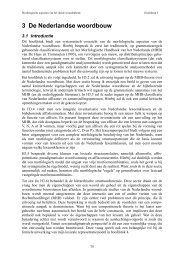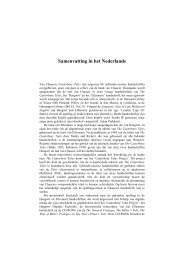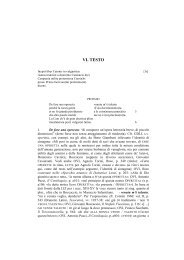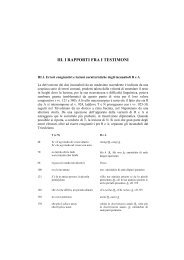Chapter 8: Other Verb-Phrase Operations - LOT publications
Chapter 8: Other Verb-Phrase Operations - LOT publications
Chapter 8: Other Verb-Phrase Operations - LOT publications
You also want an ePaper? Increase the reach of your titles
YUMPU automatically turns print PDFs into web optimized ePapers that Google loves.
8 OTHER VERB-PHRASE OPERATIONS<br />
This chapter is concerned with verbs and verb phrases, as is <strong>Chapter</strong> 7. While the<br />
preceding chapter describes verbal prefixes and the arrangement of arguments in the<br />
clause, the present chapter deals with the remaining operations associated with verbs<br />
or verb-phrase: verbalization (8.1), verbal compounding (8.2), reduplication (8.3),<br />
and tense, aspect, mode (TAM for short), as well as other adverbial modifications<br />
(8.4).<br />
8.1 <strong>Verb</strong>alization<br />
<strong>Verb</strong>alization derives a verb from a noun root. This process has been described in<br />
separate sub-sections in <strong>Chapter</strong> 7. To put them together, verbalization is<br />
accomplished through unmarked derivation (or zero morphology, see 7.1.3.1) and<br />
the causative pe- (see 7.1.3.1).<br />
Note that a kind of reversed process is also associated with Mualang verbs viz.<br />
nominalization that changes verbs into nouns. Nominalization is discussed in section<br />
4.2 of <strong>Chapter</strong> 4.<br />
8.2 <strong>Verb</strong>al compounding<br />
The whole discussion pertinent to nominal compounding as described in section 4.4<br />
of chapter 4 is also applicable to verbal compounding, except that the latter<br />
expresses events or states. As with nominal compounds, verbal compounds can be<br />
grouped as being generic (8.2.1) and specific (8.2.2). Following these two subsections,<br />
in (8.2.3) the use of verbal compounds will be exemplified.<br />
8.2.1 Generic compounds<br />
As with generic nominal compounds (4.4.1), constituents in a verbal generic<br />
compound are strung together to form a single generic meaning. The constituents are<br />
verbal roots belonging to similar or related semantic domains. They are semantically<br />
combined to form a variety of actions or states occurring in a situation.<br />
(8-1) pakay-sumay (eat-cook) ‘do activities related to cooking and eating’<br />
pakay-ipung (eat-eat) ‘eat without side dishes (eat a simple meal)’<br />
pakay-mpa’ (eat-chew) ‘eat (around), simply eat whatever is served’<br />
tipah-biah (reject.by.pushing.aside-wave.aside) ‘reject totally and<br />
rudely by hitting aside’<br />
beri’-jua’ (give-give) ‘give generously’
182 A Grammar of Mualang<br />
rantak-irit (draw-draw) ‘draw and draw’<br />
beli-belany’a (buy-do.shopping) ‘buy things’<br />
tampar-terejang (slap-run.into) ‘hit and beat’<br />
sipak-ten’ang (kick-kick.out) ‘kick out (at) intensely with all kinds of<br />
kicking’<br />
pulay-balik (come.home-return) ‘go back and forth’<br />
amis-lengis (finished-thoroughly.clean/cleared) ‘finished completely’<br />
rung’u’-pedih (sick-sick/sad) ‘seriously sick’<br />
pangkap-berap (hug-embrace) ‘embrace and hug’<br />
sium-lulum (kiss-kiss) ‘kiss and kiss’<br />
The members of these compounds are semantically closely related. In some cases<br />
the whole compound has become frozen (both constituents being precategorial;<br />
examples 8-2a), whereas in other cases (only) one of the members is never used by<br />
itself but only as a constituent of a compound (examples 8-2b):<br />
(8-2) a. peluntang-pelanting ‘helter-skelter’<br />
kun’ang-katang ‘go back and forth’<br />
kulang-kalik ‘go back and forth’<br />
b. bolak-balik (precategorial-return) ‘go back and forth’<br />
getar-ganyar (tremble-precategorial) ‘tremendously tremble’<br />
putih-belanyi (white-precategorial) ‘very white’<br />
pamar-piar (separated-precategorial) ‘scattered around, dispersed’<br />
mati-lesi (die-precategorial) ‘die (away)’<br />
barah-buruh (precategorial-hurried) ‘be in a big hurry’ 1<br />
bereta-berama (together-precategorial) ‘together’<br />
pelintang-putang (lie.across-precategorial) ‘be in disarray’<br />
pabit-parit (involve-precategorial) ‘involve/drag one another into’<br />
mutah-jurah (vomit-precategorial) ‘vomit excessively’<br />
8.2.2 Specific compounds<br />
As with some of the nominal compounds (see 4.4.2 of <strong>Chapter</strong> 4), verb phrases<br />
containing a verb and usually a noun, may become frozen lexically acquiring a<br />
specific meaning, e.g.:<br />
(8-3) pinta’-diri’ (ask-self) ‘ask permission to leave’<br />
un’ur-diri’ (withdraw-self) ‘resign’<br />
any’ung-ramu (escort-things) ‘(ceremonially) escort brideprice’<br />
mati-pungkak (die-young(?)) ‘die at a young age’<br />
1 The form buruh-arah also occurs with the same meaning.
<strong>Chapter</strong> 8: <strong>Other</strong> <strong>Verb</strong>-<strong>Phrase</strong> <strong>Operations</strong> 183<br />
kibaw-manuk (wave-chicken) ‘wave at a chicken (in a rite)’<br />
limpang-umung (switch.direction-talk) ‘by the way’<br />
pan’i’-nemiak (bathe-child) ‘bathe a child ritually’<br />
tunsun-purih (arrange-descendant) ‘track down the history of<br />
descendants’<br />
mayin-alu (play-pestle) ‘play k.o. traditional game’<br />
rari-diri’ (run-self) ‘run away’<br />
berani-mati (brave-die) ‘be ready to take a risk’<br />
8.2.3 Use of verbal compounds with and without voice prefixes<br />
Like verbal roots, compounds from verb roots appear in clauses with different voice<br />
prefixes, depending on their meaning. As attested in the data, those with intransitive<br />
meaning are zero marked (8-4 and 8-5) or prefixed with the middle te- (8-6), while<br />
those with transitive meaning can be used with prefixes of the active N- (8-7 and 8-<br />
8), the passive da- (8-9), the inverse (8-9), and the antipassive ba- (8-10):<br />
(8-4) Ia ba-guay peluntang-pelanting.<br />
3s ANPAS-run helter-skelter<br />
‘He ran helter-skelter.’<br />
(8-5) Malam, sida’ tin’uk-ngantuk.<br />
night 3p sleep-feel.sleepy<br />
‘At night they all had a sleep (i.e. felt sleepy, and then slept).’<br />
(8-6) ... Putung Kempat te-puntang-panting<br />
P K MID-precategorial-do.with.great.effort<br />
anyut ....<br />
swept.away<br />
‘… Putung Kempat was hit here and there being swept away ….’ (by<br />
an eddy of water)<br />
(8-7) Ditu’ ku N-pakay nyamay, din anak-bini ku<br />
here 1s ACT-eat comfortable there.(far) child-wife 1s<br />
N-pakay-N-ipung.<br />
ACT-eat-ACT-eat.without.sidedishes<br />
‘Here I have been eating well, overthere my wife and child eat plain<br />
rice (a very simple meal).’<br />
(8-8) Udah ia’, sida’ N-pinta’ diri’ pulay.<br />
already that’ 3p ACT-ask self go.home<br />
‘After that they asked permission to leave.’
184 A Grammar of Mualang<br />
(8-9) Nti’ aday ti taw’ da-beri’-jua’ barang ka ayung<br />
if exist REL can PASS-give-give thing to relatives<br />
nya’, aw’, kita beri’-jua’!<br />
that well 1p.incl. give-give<br />
‘If there are things (e.g. food, clothes) that could be given away to<br />
relatives, then, we give them!’<br />
(8-10) Ba-sabak dih sida’ menyadi’, ba-sium – ba-lulum,<br />
ANPAS-cry dih 3p siblings ANPAS-kiss–ANPAS-kiss<br />
ba-pangkap – ba-berap.<br />
ANPAS-hug–ANPAS-embrace<br />
‘Those siblings then cried, gave big kisses and hugs to one another.’<br />
In many cases the verbal components of the generic compound have both the same<br />
prefix, as in (8-7) and (8-10). However, the compound stem can also take only one<br />
prefix, as in (8-6) and the first clause of (8-9), in which the prefix is attached to the<br />
first element. This is probably due to the elements being very tightly integrated<br />
semantically and structurally.<br />
<strong>Verb</strong>al compounds may also be formed from denominal verbs, prefixed with the<br />
antipassive ba- or the active N- (8-11a) and from a nominal compounds (8-11b)<br />
through prefixation with ba-:<br />
(8-11) a. N-keparat–N-bansat ‘(ACT-heathen–ACT-scoundrel) ‘scold<br />
(somebody)’<br />
ba-laya’–ba-tengi’ (ANPAS-quarrel–ANPAS-dispute) ‘have<br />
disputes’<br />
bar-anak–ba-buah (ANPAS-child–ANPAS-fruit) ‘have<br />
descendants’<br />
ba-uti’–ba-guraw (ANPAS-disturb–ANPAS-tease) ‘tease<br />
around’<br />
ba-padi–ba-beras (ANPAS-paddy–ANPAS-uncooked.rice) ‘own<br />
or harvest rice abundantly’<br />
ba-babi–ba-manuk (ANPAS-pig–ANPAS-chicken) ‘own or<br />
raise lots of stocks’<br />
b. ba-laki–bini (ANPAS-husband-wife) ‘get married; be husband and<br />
wife’<br />
ba-rumah–tang’a’ (ANPAS-house–ladder ‘have a house or<br />
household’<br />
In verbs derived from nominal compounds (examples 8-11b) the nouns had a tighter<br />
semantic integration prior to prefixation. In compounds formed from prefixed nouns<br />
(examples 8-12b, 8-13b), however, each prefixed noun contributes separately to the<br />
meaning of the compound. Compare the following clause pairs:
<strong>Chapter</strong> 8: <strong>Other</strong> <strong>Verb</strong>-<strong>Phrase</strong> <strong>Operations</strong> 185<br />
(8-12) a. Udah ia’, sida’ tay ka’ ba–laki-bini ....<br />
already that 3p REL FUT ANPAS-husband-wife<br />
(= ba- + laki-bini)<br />
‘After that, they who were going to get married ....’<br />
b. Sida’ tay ba-laki–ba-bini .... (= ba-laki + ba-bini)<br />
3p REL ANPAS-husband-ANPAS-wife<br />
‘Those who are already married ....’ Or also:<br />
‘Those who have a husband and who have a wife ....’<br />
(8-13) a. Sida’ ia’ bar-anak – buah. (= bar- + anak-buah)<br />
3p that ANPAS-child-fruit<br />
‘They have helpers.’<br />
b. Anti’ mati, sida’ nsia naday bar-anak –<br />
if die 3p human NEG ANPAS-child-<br />
ba-buah.<br />
(= bar-anak + ba-buah)<br />
ANPAS-fruit<br />
‘If they are dead, they, the human beings, won’t have<br />
descendants (anymore).’<br />
Some compounds with the (b) pattern of (8-12) and (8-13) seem to have become<br />
frozen lexically, for example, bereta-berama (together-precategorial) ‘together’, in<br />
which the ba- syllables are reduced forms of former ba- prefixes.<br />
In sum, verbal compounds occur in the following structural patterns (each<br />
followed by an example):<br />
a) zero marked or [verbal compound], e.g. kun’ang-katang ‘go back and<br />
forth’;<br />
b) Prefix-[verbal compound], e.g. N-pinta’ diri’ (ACT-ask–self) ‘ask<br />
permission to leave’;<br />
c) [Prefix-verb]-[Prefix-verb], e.g. N-pakay–N-sumay (ACT-eat–ACT-cook)<br />
‘cook and have a meal’<br />
d) Prefix-[nominal compound], e.g. ba-laki–bini (ANPAS-husband–wife) ‘get<br />
married’;<br />
e) [Prefix-noun]-[Prefix-noun], e.g. bar-anak–ba-buah (ANPAS-child–<br />
ANPAS-fruit) ‘have descendants’.<br />
Structurally the generic verbal compounds may resemble verb sequences and<br />
serial verb constructions (see <strong>Chapter</strong> 10). <strong>Verb</strong>al compounds mainly exhibit highly<br />
semantic – hence structural – integrity between their constituents, and therefore<br />
their members have to be closely related semantically. In a verb sequence, there is a<br />
pause between the verbs, which signals that the activities are carried out separately.<br />
Compare the sequence of verbs in (8-14) below with the compound in (8-5) above:
186 A Grammar of Mualang<br />
(8-14) Sida’ ngantuk, tin’uk.<br />
3p feel.sleepy sleep<br />
‘They felt sleepy and slept (then went to sleep).’<br />
(8-14) differs from (8-5) in that in the latter case the whole process or situation<br />
related to being sleepy, going to sleep until falling asleep is wrapped semantically<br />
into one compound form. Note also that in (8-14) the order of the verbs iconically<br />
reflects the order of the events referred to, which is not necessarily the case in<br />
compounds.<br />
<strong>Verb</strong>al compounds differ from serial verbs in that the latter are multi-clausal<br />
structurally, and semantically one of their constituent members modifies the other in<br />
some ways, hence their constituent members vary and belong to different semantic<br />
fields. <strong>Verb</strong>al compounds, on the other hand, are mono-clausal and semantically<br />
they refer to one single activity or state.<br />
However, some constituents that frequently occur in compounds also appear in<br />
verb sequence. Such sequences occur with words that are not precategorial. The<br />
resultant parallelisms are often found in ritual texts, e.g. as in (8-16) and (8-17). This<br />
might suggest a historical multi-clausal source of verbal compounding (cf. the<br />
regular multi-clausal sentence in (8-15)).<br />
(8-15) Nema N-suruh balang mati tih, nyaw<br />
therefore ACT-cause fail dead tih already<br />
da-tipah aba’ da-biah ay’ inum ....<br />
PASS-push.aside and PASS-wave.aside water drink<br />
‘Because (what) caused (them) not to die was that the drinking water<br />
was hit aside (and fell) ....’<br />
(8-16) Tu’ mah kami N-kibaw kami N-kitaw, kami<br />
this mah 1p.excl. ACT-wave 1p.excl ACT-wave 1p.excl<br />
N-tipah kami N-biah...<br />
ACT-push.aside 1p.excl. ACT-wave.aside<br />
‘Here we’re doing the offerings (by all kinds of waving activities,<br />
usually with a kind of leaf).’ (Cited from Paternus (2001:30))<br />
(8-17) ...da-pampas juata jawa’ isa’ mis,<br />
PASS-reward god k.o.plant in.order.that finished<br />
isa’ cawis, isa’ lengis.<br />
in.order.that finished in.order.that cleared<br />
‘... (Whoever hinders) will be rewarded (i.e. punished) until utterly and<br />
completely wiped out (by the god).’ (Cited from Paternus (2001:54))
<strong>Chapter</strong> 8: <strong>Other</strong> <strong>Verb</strong>-<strong>Phrase</strong> <strong>Operations</strong> 187<br />
8.3 <strong>Verb</strong>al reduplication<br />
<strong>Verb</strong>al reduplication is more variegated than nominal reduplication (see 4.3 of<br />
<strong>Chapter</strong> 4) both structurally and semantically. Basically verbal reduplication is a<br />
grammatical strategy used to code the same event as indicated by the nonreduplicated<br />
verb (action or state) but repeatedly or continuously for a particular<br />
period of time. 2 Structurally the verb base coding the event is reduplicated in several<br />
ways, signaling the degree of semantic integrity of the repetitive or durative event.<br />
Structurally the reduplication may be regarded as morphological and syntactic; both<br />
will be described below in 8.3.1 and 8.3.2 respectively.<br />
8.3.1 Morphological reduplication<br />
<strong>Verb</strong>al morphological reduplication shows a highly semantic integrity of the same<br />
action or state occuring repetitively during a particular period of time. The<br />
repetitions are not conceived of as separate situations characterized by the same<br />
event (see syntactic reduplication below), but rather as a single event. Morphological<br />
reduplication vs. syntactic reduplication may be compared to verbal compounding<br />
vs. serial verbs or verb sequences (cf. 8.2. above). For example, consider (8-18):<br />
(8-18) a. Kacung N-lumpat. (= non-repetitive action)<br />
frog ACT-jump<br />
‘The frog jumped.’<br />
b. Kacung N-lumpat-lumpat.(= morphological reduplication)<br />
frog ACT-jump-RED<br />
‘The frog jumped around.’<br />
c. Kacung N-lumpat, N-lumpat (sampay jawuh).<br />
frog ACT-jump ACT-jump until far<br />
(= syntactic reduplication)<br />
‘The frog jumped, and jumped (until it was far away).’<br />
In (8-18a) the action of jumping took place one time (or is referred to as an invariant<br />
habit); in (b) it took place many times but as a whole the repetitions are regarded as<br />
expressing a single complex movement, e.g. up and down aimlessly. In (c), each<br />
verb describes a separate event, the same as in the first interpretation of (a).<br />
Morphological reduplication is a derivational process which as such may result in<br />
some unexpected changes in meaning and word class, as will be described further<br />
below.<br />
Formally, there are several patterns of morphological reduplication:<br />
2 Some words are characterized by “lexical repetition”, i.e. they look like reduplicated forms,<br />
but lack a non-reduplicated base. Examples are: silu-silu ‘quiet’ (cf. silu ‘nail’), mang-mang,<br />
usually used in the expression naday mang-mang ‘suddenly’. By definition such words are<br />
not considered the product of a synchronic process of morphological reduplication.
188 A Grammar of Mualang<br />
1) Full reduplication of the root without further affixation, e.g.:<br />
lubah-lubah (slow.and.quiet-RED) ‘slowly and quietly’<br />
mit-mit (small-RED) ‘in small sizes/amounts/pieces’<br />
sigat-sigat (quick-RED) ‘quickly’<br />
sikit-sikit (little-RED) ‘little by little’<br />
tuay-tuay (old-RED) ‘moderately old’<br />
idup-idup (live-RED) ‘alive’<br />
If the root is prefixed for voice with a syllabic prefix, the reduplication still applies<br />
to the whole root, e.g.:<br />
ba-guay-guay (ANPAS-run-RED) ‘run (continuously), run around’<br />
ba-pin’ah-pin’ah (ANPAS-move-RED) ‘move (around) from one place<br />
to another’<br />
da-kayuh-kayuh (PASS-paddle-RED) ‘be paddled (continuously)’<br />
da-tiki’-tiki’ (PASS-climb-RED) ‘be climbed (continuously)’<br />
te-bagi-bagi (MID-divide-RED) ‘get divided up’<br />
te-tucuk-tucuk (MID-stab-RED) ‘get stabbed repeatedly’<br />
N-lumpat-lumpat (=ngelumpat-lumpat) (ACT-jump-RED) ‘jump<br />
around/repeatedly’<br />
N-labuh-labuh (=ngelabuh-labuh) (ACT-drop-RED) ‘drop repeatedly’<br />
N-rusak-rusak (ngerusak-rusak) (ACT-broken-RED) ‘break/damage<br />
repeatedly’<br />
If the prefix is non-syllabic (allomorphs of N- with roots which do not begin with l<br />
or r), the whole prefixed word is reduplicated:<br />
N-ili’-N-ili’ (ngili’-ngili’) (ACT-downstream-RED) ‘continuously go<br />
downstreams’<br />
N-bunuh-N-bunuh (munuh-munuh) (ACT-kill-RED) ‘kill repeatedly’<br />
N-kampur-N-kampur (ngampur-ngampur) (ACT-chat-RED) ‘chat<br />
repeatedly/on and on’<br />
N-pakay-N-pakay (makay-makay) (ACT-eat-RED) ‘have a meal (with<br />
various ingredients/dishes and relatively long)’<br />
However, in practice the reduplication of words can be limited in length<br />
phonologically. On the average more than four syllables in total may be considered<br />
too long and not economical, and so cases of phonological truncation are also heard,<br />
notably in rapid speech, e.g. ba-terudi–terudi baterudi-rudi (ANPAS-chase.after-<br />
RED) ‘follow/compete with one another’, ba-keramak–ramak (ANPAS-claw-RED)<br />
‘claw (each other) on and on’, ba-macam–macam bamamacam (ANPAS-kind-<br />
RED) ‘be of many kinds, various’.<br />
Full reduplication is common in the language. Semantically, some additional<br />
meanings may arise depending on the verb type. Reduplication with transitive and<br />
dynamic intransitive verbs normally does not change the lexical meaning of the<br />
base. In (8-19) and (8-20) the reduplicated form indicates duration of the activity. In
<strong>Chapter</strong> 8: <strong>Other</strong> <strong>Verb</strong>-<strong>Phrase</strong> <strong>Operations</strong> 189<br />
the case of transitive verbs reduplication may also imply plurality of the patient (8-<br />
21):<br />
(8-19) N-inaw–N-inaw apa, m’ih?<br />
ACT-look.for-RED what 2s.masc<br />
‘What have you been looking for (since some time ago)?’<br />
(8-20) Miak ia’ ba-sabak–sabak.<br />
child that ANPAS-cry-RED<br />
‘The child keeps crying.’<br />
(8-21) Babas da-tebas-tebas sampay luah.<br />
forest PASS-cut-RED until large<br />
‘A wide area of forest is cleared (by cutting grass and bushes/trees).’<br />
Reduplicated static intransitive verbs may be used predicatively (8-22 – 8-24)<br />
and attributively (8-25 – 8-27). In such usages, the reduplicated forms express that<br />
the state indicated by the verbal root is on the average the case (with the implication<br />
that the noun of which it is said to be the case is a mass noun, as in (8-22), or has to<br />
be interpreted as plural as in (8-25 and 8-26), or is true to a relative extent (as in (8-<br />
23, 8-24 and 8-27)).<br />
(8-22) Padi nyaw kuning-kuning.<br />
rice already yellow-RED<br />
‘The rice has all become yellow.’<br />
(8-23) Ku bayik-bayik ja’.<br />
1s good-RED ja’<br />
‘I am just fine.’<br />
(8-24) Urang nya’ mit-mit.<br />
person that small-RED<br />
‘That person is small (i.e. on the average he has a small and short<br />
body).’<br />
(8-25) kayu mit-mit<br />
wood small-RED<br />
‘wood in small pieces’<br />
(8-26) urang tuay-tuay<br />
person old-RED<br />
‘on the average old people’
190 A Grammar of Mualang<br />
(8-27) urang bayik-bayik<br />
person good-RED<br />
‘on the average good person (of behaviour)’<br />
Reduplicated static intransitive verbs are also used with another verb, in which case<br />
they function adverbially expressing various manners with intensifying meaning.<br />
The event coded in the verb root itself implies a repetitive or durative action or state.<br />
As adverbs, their position in the clause is relatively flexible. Some examples:<br />
sigat-sigat ‘very fast (as fast as one could be)’<br />
lubah-lubah ‘very slowly and quietly (as much as one could be)’<br />
bayik-bayik ‘very carefully (as careful as one could be)’<br />
mimit-mimit ‘little by little’<br />
jawuh-jawuh ‘very far (as far as one could be)’<br />
amat-amat ‘really’<br />
mati-mati ‘with extremely great effort’<br />
idup-idup ‘alive’<br />
(8-28) Piara-idup bayik-bayik!<br />
take.care.of-live good-RED<br />
‘Cultivate it and grow it carefully!’<br />
(8-29) Am’i’ mimit-mimit!<br />
take little-RED<br />
‘Take little by little’<br />
(8-30) Lubah-lubah ia turun.<br />
slow.and.quiet-RED 3s descend<br />
‘Slowly and quietly he came down.’<br />
(8-31) Ia mati-mati N-tam’ak padi.<br />
3s die-RED ACT-plant rice<br />
‘He worked very hard planting the rice.’<br />
2) Reciprocal reduplication. This reduplication applies only to ba-verbs, with the<br />
following pattern: root–ba-root. It denotes that the action is repeatedly carried out<br />
one against or after another, e.g.:<br />
balas–ba-balas (den’am) (pay.back–ANPAS-RED) (revenge) ‘take<br />
revenge on one another’<br />
bunuh–ba-bunuh (kill–ANPAS-RED) ‘be engaged in killing each other’<br />
bantu–ba-bantu (help–ANPAS-RED) ‘be engaged in helping each other’<br />
tim’ak–ba-tim’ak (shoot–ANPAS-RED) ‘be engaged in shooting each<br />
other’<br />
tugal–ba-tugal (dibble–ba-RED) ‘be engaged in making holes for seeds<br />
one after another’
<strong>Chapter</strong> 8: <strong>Other</strong> <strong>Verb</strong>-<strong>Phrase</strong> <strong>Operations</strong> 191<br />
sawut–ba-sawut (reply–ANPAS-RED) ‘be engaged in replying to each<br />
other’<br />
As seen in the following examples, the subject of the clause is always plural:<br />
(8-32) Melia’ ah, sida’ balas–ba-balas den’am.<br />
in.old.times ah 3p repay-ANPAS–RED revenge<br />
‘In the old times they took revenge on one another.’<br />
(8-33) Sida’ ia’ kayuh–ba-kayuh.<br />
3p that paddle-ANPAS-RED<br />
‘They paddled (the proa) one after another.’<br />
(8-34) Burung sawut–ba-sawut.<br />
bird reply-ANPAS-RED<br />
‘Birds are replying to one another.’<br />
Lexically reciprocal verbs may also be reduplicated “regularly”, e.g. ba-bunuh–<br />
bunuh ‘kill each other’, ba-tulung–tulung ‘help each other’. However, they differ<br />
from the “reciprocal reduplication” in that the regular reduplication does not<br />
necessarily yield a reciprocal meaning, thus babunuh-bunuh can also mean<br />
‘repeatedly engage in killing activity’.<br />
3) Reduplication with sound changes in the root. In this pattern, the whole root is<br />
reduplicated, but with some changes or variations in one or some of its phonemes<br />
(mostly vowels). There is no regular phonological pattern of changes that can be<br />
reconstructed. Most of such reduplicated forms have been lexicalized or fixed in<br />
pairs. Sound changing reduplication expresses a repetitive occurence of the same<br />
event in a variety of ways (sounds, emotions, movements, situations, etc.), e.g.:<br />
tekakak-tekikik ‘laugh continuously with various sounds’<br />
kasak-kusuk ‘be restless with all kinds of busy movements’<br />
bulak-balik ‘be busy with going to and returning from a particular place’<br />
kucar-kacir ‘be scattered around (into all kinds of places or directions)’<br />
kutak-katuk ‘make various sounds of tapping’<br />
licak-lacik ‘very muddy and wet’<br />
kerap-terap ‘fall/get stumbled here and there’<br />
8.3.2 Syntactic reduplication<br />
Syntactic reduplication shows a process of repetition of the same event. Formally<br />
there are two kinds of syntactic reduplication:<br />
1) verb ka verb: this kind of reduplication conveys continuity, a process of<br />
becoming more and more, e.g.:
192 A Grammar of Mualang<br />
besay ka besay ‘become bigger and bigger’<br />
panay ka panay ‘become smarter and smarter’<br />
taw’ ka taw’ ‘become more and more knowledgeable’<br />
bayik ka bayik ‘become better and better’<br />
semak ka semak ‘come closer and closer’<br />
ketawa’ ka ketawa’ ‘continue to laugh’<br />
N-sabak ka N-sabak (ACT-cry to ACT-cry) ‘continue to cry’<br />
N-ili’ ka N-ili’ (ACT-downstream to ACT-downstream) ‘continue to go<br />
downstream’<br />
da-salay ka da-salay (PASS-dry.over.fire to PASS-dry.over.fire) ‘continue to<br />
dry over the fire’<br />
da-gulay ka da-gulay (PASS-mix to PASS-mix) ‘continue to mix’<br />
(8-35) Miak ia’ besay ka besay.<br />
child that big to big<br />
‘The child is growing bigger and bigger.’<br />
(8-36) Sida’ N-ili’ agi’, N-ili’ agi’<br />
3p ACT-downstream again ACT-downstream again<br />
Ketungaw. N-ili’ ka N-ili’,<br />
K ACT-downstream to ACT-downstream<br />
N-ili’ ka N-ili’, baru’ datay<br />
ACT-downstream to ACT-downstream then come<br />
ka ili’.<br />
to downstream<br />
‘They went downstream on the Ketungau River again, they went down<br />
the river. They kept going downstream, then they arrived downstream.’<br />
(8-37) Nemiak ia’ N-sabak ka N-sabak ka’ angkat.<br />
child that ACT-cry to ACT-cry want go<br />
‘The child keeps crying wanting to go.’<br />
(8-38) Beram ia’ da-salay ka da-salay<br />
alcohol that PASS-dry.over.fire to PASS-dry.over.fire<br />
sampay ay’ nya’ mirah.<br />
until water that red<br />
‘The beram is heatened more and more until the water turns red.’<br />
2) A verb can also simply be repeated to express a repetition. Each repetition has its<br />
own word stress, hence these verbs do not constitute a single phrase. Examples of<br />
this can be seen in (8-18c) and the first clause of (8-36).
<strong>Chapter</strong> 8: <strong>Other</strong> <strong>Verb</strong>-<strong>Phrase</strong> <strong>Operations</strong> 193<br />
Finally, a reduplicated form can become lexicalized with a particular meaning,<br />
e.g. kun’ang-kekun’ang ‘go back and forth’.<br />
8.4 Tense, aspect, mode and other adverbial modifications<br />
In this section the primary ways of expressing tense (8.4.1), aspect (8.4.2), mode<br />
(8.4.3) and other adverbial expressions (8.4.4) are described.<br />
8.4.1 Tense<br />
So-called “tense” (i.e. “the relation of the time of an event to some reference point in<br />
time” (Payne 1997:236)) is not expressed grammatically in Mualang. It is simply left<br />
unspecified and disambiguated by the context:<br />
(8-39) M’ih N-pakay apa?<br />
2s.masc ACT-eat what<br />
(a) ‘What did you eat?’<br />
(b) ‘What are you eating?’<br />
(c) ‘What will you eat/are you going to eat?’<br />
A time adverb can be used to explicitly specify the temporal relations involved.<br />
Generally time adverbs refer to various situations in the past, present and future,<br />
e.g.:<br />
- past: melia’ ‘in the old times’, dulaw ‘formerly, a long time ago’,<br />
kemari’ ‘yesterday’, tadi’ ‘a while ago’, baru’ ‘just a while ago’;<br />
- present: tu’ ‘now’ (locationally it means ‘this’), nyaw pitu’ ‘now,<br />
nowadays’, ke tu’ ‘to the present time’ (locationally it means ‘to<br />
this’);<br />
- future: pagi ‘tomorrow’, ila’ ‘later’, dudi ari ‘in the coming days’.<br />
(8-40) Dulaw tih, ia keran kitu’.<br />
fomerly tih 3s often hither<br />
‘Before, he often came here.’<br />
(8-41) Nyaw pitu’ rumah panyay nisi’ agi’...<br />
already like.this house long EXIST.NEG again<br />
‘Nowadays there are no longhouses anymore ...’<br />
(8-42) Ila’ ku kin.<br />
later 1s thither.(far)<br />
‘I’ll go over there later.’<br />
It is only ‘near future’ that is expressed in the form of an auxiliary, namely ka’ ‘be<br />
going to’ (see also <strong>Chapter</strong> 10 on serial verbs):
194 A Grammar of Mualang<br />
(8-43) Ka’ kikay, di’?<br />
FUT to.where 2s.fem<br />
‘Where are you going?’<br />
8.4.2 Aspect<br />
Comrie (1981:3) gives a general definition for aspect as “different ways of viewing<br />
the internal temporal constituentcy of a situation.” A similar definition is provided<br />
by Payne (1997:238): “aspect describes the internal temporal shape of events or<br />
states.” In Mualang, aspectual meanings are expressed analytically by means of<br />
auxiliaries, or they can be deduced from the context. A discussion of aspectual<br />
auxiliaries is given here:<br />
a. Perfect aspect: nyaw, udah ‘already’<br />
Both nyaw and udah express perfect aspect. In certain contexts they are translatable<br />
as ‘already’. In many constexts their meanings overlap and they may be used<br />
interchangeably, hence the difference between them is subtle. 3 Udah (phonologically<br />
reduced to dah) also has developed into an illocutionary marker (see 9.4 in <strong>Chapter</strong><br />
9). In the construction udah ia’ ‘after that’ which functions as a kind of conjunction<br />
(see section 10.6.1.4) udah cannot be replaced by nyaw. As a perfect auxiliary, udah<br />
emphasizes the accomplishment of an event while it also makes a contrast between<br />
the state of affairs “before” and “after”. Nyaw does not seem to imply such a change<br />
in the state of affairs; it simply refers to something that has happened, e.g.:<br />
(8-44) Ia N-peda’ urang tuay, buk nyaw putih.<br />
3s ACT-see person old hair already white<br />
‘He saw (met) an old person, her hair was already grey.’<br />
(8-45) Ia N-peda’ urang tuay ia’ agi’, buk udah putih.<br />
3s ACT-see person old that again hair already white<br />
‘He saw (met) that old person again, her hair had turned grey<br />
(compared to the last time he saw her).’<br />
In (8-46) the use of nyaw again merely presents a statement about what has<br />
happened, but udah in (8-47) implies the speaker’s deliberate accomplishment of the<br />
activity (he wanted to do something and he did it already):<br />
(8-46) Antu nyaw N-dinga gu’ Apay Aluy.<br />
ghost PERF ACT-hear sound father A<br />
‘(Beyond Aluy’s father’s expectation) the ghost has heard father of<br />
Aluy’s father’s voice.’<br />
3 To some extent the similarity between nyaw and udah may be comparable to Indonesian<br />
telah and sudah. See, for example, Minde and Tjia (2002), for a discussion about the latter and<br />
related matter in Ambonese Malay.
<strong>Chapter</strong> 8: <strong>Other</strong> <strong>Verb</strong>-<strong>Phrase</strong> <strong>Operations</strong> 195<br />
(8-47) Ku udah N-padah ka ia.<br />
1s PERF ACT-say to 3s<br />
‘I have told him.’<br />
b. Progressive aspect: tengan, benung: 4<br />
(8-48) Ia tengan N-pakay.<br />
3s PROG ACT-eat<br />
‘He is/was eating.’<br />
(8-49) Nti’ benung kita’ ba-laya’ ...<br />
if PROG 2p ANPAS-quarrel<br />
‘If you were having a quarrel ...’<br />
Tengan is commonly used, whereas benung is rare; it is considered as an old word.<br />
c. Durative aspect: lagi’/agi’ ‘still’ 5<br />
(8-50) Ia bedaw 6 angkat. Agi’ N-pan’i’.<br />
3s not.yet go still ACT-bathe<br />
He’s not going yet. He’s still taking a bath.’<br />
d. Completive: mis ‘finished’<br />
(8-51.) Nti’ kita’ mis ba-kerja, ....<br />
if 2p finished ANPAS-work<br />
‘If you all are finished working, ....’<br />
Mis is also used as a main verb (see <strong>Chapter</strong> 10 on serial verbs).<br />
e. Repetitive/semelfactive aspect: kepa’ ‘often’; keran ‘like to do, often do’; gah<br />
‘ever, once’; kadang/kadang-kadang/tekadang ‘sometimes’; jarang ‘seldom, rarely’<br />
(8-52) Urang dah kepa’ N-pinta’ ia.<br />
person PERF often ACT-ask.for 3s<br />
‘People have often courted her.’<br />
(8-53) Keran ka Punti?<br />
like to P<br />
‘Do you like going/often go to the city of Pontianak?’<br />
4 Sometimes the alternant form tengah ‘middle’ was heard instead of tengan.<br />
5 Note that as an adverb (l)agi’ means ‘again’.<br />
6 Bedaw is the negation of nyaw/udah. See section 9.5 of the next chapter on negation.
196 A Grammar of Mualang<br />
(8-54) Ku gah ka rumah ia.<br />
1s ever to house 3s<br />
‘I have ever been to his house.’<br />
(8-55) N-tanya’ ka ti in’u’ ia’, kadang-kadang naday<br />
ACT-ask to REL female that sometimes NEG<br />
N-sawut.<br />
ACT-reply<br />
‘(We) asked to that female, sometimes she did not reply.’<br />
(8-56) Nti’ aday, ulih jarang.<br />
if exist but seldom<br />
‘If there was, it was however rare.’<br />
The aspectual meaning of the auxiliary keran may have developed from its usage as<br />
a verb meaning ‘like’, as in (8-57) below. Its iterative meaning may be derived from<br />
the sense “like to do something again and again”. Hence, it implies habituality.<br />
(8-57) Ia keran N-pakay jimut.<br />
3s like eat k.o.snack<br />
‘He likes to eat jimut.’<br />
Gah ‘ever’ sometimes may be interpreted as ‘several times’. Mualang has special<br />
expressions for ‘never’, namely naday kala’ and nikala’ ‘never’. 7<br />
The iterativity of kepa’ and keran differs from the one expressed by<br />
reduplication in that in the latter it is only concerned with a repetitive occurrence of<br />
a single event at one single time, whereas in the former, a single event is iterated on<br />
and on over time and not once at a particular time.<br />
f. Habitual aspect: biasa ‘usually’, nitaw’ ‘habitual inability’<br />
(8-58) Nema biasa kita Mualang tu’ ti laki<br />
because usually 1p.incl M TOP REL male<br />
N-tugal, ti in’u’ N-benih.<br />
ACT-dibble REL female ACT-seed<br />
‘Because it is usual for us, the Mualang, the men do the dibbling, the<br />
women put the seeds in.’<br />
(8-59) Sida’ nitaw’ ba-laya’.<br />
3p HAB.INAB ANPAS-quarrel<br />
‘They don’t get used to having quarrels.’<br />
7 The short form kala’ ‘never’ also exists e.g. Kala’ ku N-dinga .... ‘I’ve never heard of ....’
<strong>Chapter</strong> 8: <strong>Other</strong> <strong>Verb</strong>-<strong>Phrase</strong> <strong>Operations</strong> 197<br />
A combination of tense-aspect auxiliaries is also attested, as in (8-52) above and<br />
in the following examples:<br />
(8-60) Ku tu’ bedaw sempat pulay. Agi’ ka’<br />
1s TOP not.yet have.time go.home still FUT<br />
N-getah.<br />
ACT-sticky.sap.of.plants<br />
‘As for me, I am not ready to go home yet. I am still going to do<br />
animal-trapping with sticky sap.’<br />
(8-61) Mataari udah turun. Nyaw ka’ malam.<br />
sun PERF descend PERF FUT night<br />
‘The sun has set down. It’s already going to be night.’<br />
Some aspectual meanings may be conveyed by morphological means. Iterative<br />
meaning, as noted in 8.3 above, can be expressed by reduplication. Some verb types<br />
are more likely to be associated with a particular aspectual meaning. Te-verbs (see<br />
7.2.9 of <strong>Chapter</strong> 7), for instance, can express inchoative meaning, whereas ba-verbs<br />
tend to refer to habitual activities, e.g.:<br />
(8-62) Ia ba-uma/ ba-kerja dia’.<br />
3s ANPAS-rice.field ANPAS-work there.(near)<br />
‘He cultivates the rice field/works there.’<br />
However, overall context plays an important role. As the following example<br />
shows, once the aspectual (and tense) background has been provided or understood,<br />
it is typically omitted or not mentioned in the subsequent discourse:<br />
(8-63) A: Ia tengan N-pakay. B: Dini ia N-pakay?<br />
3s PROG ACT-eat where 3s ACT-eat<br />
A: ‘She is eating.’ B: ‘Where is she eating?’<br />
8.4.3 Mode<br />
The typology of mode is treated in somewhat different ways in the literature (cf. e.g.<br />
Chung and Timberlake 1985, Payne 1997, Givón 2001a). 8 The present discussion is<br />
meant only to provide a basic description of how the so-called category of mode,<br />
mood or modality is expressed in Mualang. Therefore, the concept of this category<br />
will be applied rather loosely. As mentioned in Payne (1997:244; cf. also Chung<br />
and Timberlake 1985:241), “the highest-level distinction in modal operations is<br />
8 The term mode is often (but not always) used interchangeably with mood and modality in<br />
the literature (Payne 1997:244). Chung and Timberlake (1985) seems to make a distinction<br />
between the term mood and mode. The present description does not attempt, however, to<br />
make such a distinction.
198 A Grammar of Mualang<br />
between realis and irrealis, though like most conceptual distinctions these terms<br />
describe a continuum. A prototypical realis mode strongly asserts that a specific<br />
event or state of affairs has actually happened, or actually holds true. A prototypical<br />
irrealis mode makes no such assertion whatsoever. Irrealis mode does not<br />
necessarily assert that an event did not take place or will not take place. It simply<br />
makes no claims with respect to the actuality of the event or situation described.”<br />
In Mualang the category of mode is primarily expressed periphrastically through<br />
modal auxiliaries or adverbs. The realis sense is apparent in the past perfective event<br />
(determined simply by the context or a temporal adverb; e.g. as in (8-64)) or in the<br />
perfect event with the auxiliary nyaw or udah ‘PERF’, as in (8-46 – 8-47) above.<br />
(8-64) Melia’ ah, sida’ balas–ba-balas den’am.<br />
in.old.times ah 3p repay-ANPAS-RED revenge<br />
‘In the old times they took revenge on one another.’<br />
Grammatically, it is only the prefixes te- (irrealis) and ke- (inchoative) that can<br />
be used to assert some sort of modal meanings (see <strong>Chapter</strong> 7 for their functions).<br />
Negation could be included in this subsection; however, it will be deferred until<br />
<strong>Chapter</strong> 9. <strong>Other</strong> kinds of irrealis assertions are expressed analytically through<br />
auxiliaries, adverbs or extraclausal particles, which will be given below. The<br />
following five sub-types can be distinguished:<br />
a. Optative: the particle kira ‘wish’; the auxiliaries arap ‘hope’, ka’ ‘want’;<br />
(8-65) Kira aday urang datay ...<br />
wish exist person come<br />
‘I wish somebody would come ...’<br />
(8-66) Ku arap wan datay kia’ wih.<br />
1s hope 2s.hon come thither.(near) wih<br />
‘I hope you’ll come there, will you?’<br />
(8-67) Ku ka’ aba’ m’ih kin.<br />
1s want follow 2s.masc thither.far<br />
‘I want to follow you thither.’ (Also: ‘I am going to follow you<br />
thither.’)<br />
b. Potential: the auxiliaries talah/alah ‘be able’; taw’ ‘can, be able to, may’; nitaw’<br />
‘cannot, may not’ 9<br />
(8-68) Ku talah N-pupuh sida’.<br />
1s be.able ACT-chase 3p<br />
‘I was able to chase after them.’<br />
9 Dapat ‘can, be able to’ was also in use, but I am not sure whether this is native to Mualang<br />
or a borrowing from Malay/Indonesian.
<strong>Chapter</strong> 8: <strong>Other</strong> <strong>Verb</strong>-<strong>Phrase</strong> <strong>Operations</strong> 199<br />
(8-69) Taw’ ku N-tiki’?<br />
can 1s ACT-climb<br />
‘May I come in?’ (lit. ‘May I climb (the ladder) up into your house’)<br />
(8-70) Nya’ mah, jang, nitaw’!<br />
that mah TOA can’t/may.not<br />
‘That, you can’t/may not (do), boy!’<br />
c. Obligation: the auxiliaries alah/arus ‘must’; perlu ‘need’; nusah ‘needn’t’<br />
(8-71) Urang, nti’ ka’ ba-kerja ba-uma, alah<br />
person if want ANPAS-work ANPAS-rice.field must<br />
N-pinta’.<br />
ACT-ask.for<br />
‘If anybody wants to work the rice field, he must ask (you for<br />
permission).’<br />
(8-72) Mayuh ti perlu da-cakap kita.<br />
many REL need PASS-talk 1p.incl<br />
‘There are many that need to be discussed by us.’<br />
(8-73) Nusah di’ angkat bah.<br />
needn’t 2s.fem go bah<br />
‘You really don’t need to go.’<br />
d. Probability: the particle amang ‘think’:<br />
(8-74) Amang ku umur agi’ lima-nam tawun.<br />
think 1s age still five-six year<br />
‘I think (maybe) her age was still about 5 or 6 years.’<br />
e. Certainty: the adverb amat ‘true, really’:<br />
(8-75) Amat ku N-padah ka m’ih.<br />
true 1s ACT-say to you<br />
‘Indeed I’ve told you (about that).’<br />
Various facets of modal senses are also found in the use of “illocutionary<br />
markers”. However, they cover more than merely modal senses or speaker’s attitude.<br />
These illocutionary markers are discussed separately in <strong>Chapter</strong> 9 (section 9.4).
200 A Grammar of Mualang<br />
8.4.4 <strong>Other</strong> adverbial modifications<br />
Adverbial modification normally adds meaning to the verb primarily via adverbs,<br />
along with several other syntactic constructions. Semantically, adverbial<br />
modification can be divided into several subclasses discussed in the next sections.<br />
8.4.4.1 Manner<br />
Adverbial manner is realized in several ways. First, by the use of serial verb<br />
constructions (=SVC; see section 10.2 of <strong>Chapter</strong> 10), in which the second verb,<br />
most likely a static intransitive verb, functions as a manner adverb to the first verb.<br />
The bold sequences in the following examples illustrate such serial verb<br />
constructions:<br />
(8-76) Tay nama pulay puang, ngay kami.<br />
REL name go.home empty not.want 1p.excl.<br />
‘What is called going home empty (i.e. if you turn down our marriage<br />
proposal), that’s something we surely don’t want to do.’<br />
(8-77) Arus ba-kerja keras=m kita’!<br />
must ANPAS-work hard=m 2p<br />
‘You all must really work hard!’<br />
Some ba-derived verbs with stative meaning may also function adverbially, e.g.:<br />
(8-78) Ka’ N-kisah kati cara ba-uma<br />
want ACT-story how way ANPAS-rice.field<br />
ba-pin’ah –pin’ah<br />
ANPAS-move-RED<br />
‘(I) want to tell you about how to do “slash and burn cultivation”.’ (lit.<br />
‘I want to tell about how to do rice field work by moving around’ (from<br />
one place to another))<br />
(8-79) Turun ba-lubah – lubah, ia N-inaw tay<br />
descend ANPAS-slow/quiet-RED 3s ACT-search REL<br />
ba-gu’.<br />
ANPAS-sound<br />
‘Descending slowly and quietly, he looked for what had made a sound.’<br />
Se-derived words may also be used adverbially, indicating the way the action of<br />
the preceding main verb is enacted (for the numeral prefix se-, see 4.1.2.1.1):
<strong>Chapter</strong> 8: <strong>Other</strong> <strong>Verb</strong>-<strong>Phrase</strong> <strong>Operations</strong> 201<br />
(8-80) Pukat Bengawan aba’ Am’un Menurun idup<br />
P B and A M live<br />
se-peN-pakay, se-peN-sumay, se-tin’uk–ngantuk ...<br />
ONE-NOM-eat ONE-NOM-cook ONE-sleep-feel.sleepy<br />
‘Pukat Bengawan and Am’un Menurun shared their lives in very<br />
respect.’ (lit. ‘Pukat Bengawan and Am’un Menurun lived being one of<br />
eating, one of cooking, one of sleeping-feeling sleepy’)<br />
Secondly, some static intransitive verbs are optionally introduced by the<br />
preposition ngaw ‘with’, while others require ngaw in order to function adverbially.<br />
Obviously further research is needed to establish possible regularities, constraints,<br />
and/or semantic differences. The following examples in (8-81 – 8-84) reflect the<br />
judgment of one of my informants:<br />
(8-81) Ia ba-guay (*ngaw) sigat.<br />
3s ANPAS-run (with) fast<br />
‘He ran fast.’<br />
(8-82) Ku ditu’ N-pakay (*ngaw) nyamay.<br />
1s here ACT-eat (with) comfortable<br />
‘Here I eat comfortably.’<br />
(8-83) Ia angkat ngaw nyamay. (?Ia angkat nyamay)<br />
3s go with comfortable<br />
‘He took off happily.’<br />
(8-84) Ia kerja (ngaw) bayik.<br />
3s work (with) good<br />
‘She works well.’<br />
Ngaw in combination with a noun (phrase) can also express manner; in which<br />
case ngaw is obviously obligatory:<br />
(8-85) ..., jaku’ ia ngaw suara ba-getar.<br />
say 3s with voice ANPAS-tremble<br />
‘..., he said with a trembling voice.’<br />
(8-86) Ngaw pedih ati urang tuay kita angkat ari<br />
with sick heart person old 1p.incl go from<br />
dia’.<br />
there.near<br />
‘Sadly and angrily our parents went away from there.’
202 A Grammar of Mualang<br />
In (8-85 – 8-86) ngaw heads a noun phrase, which structurally shows isomorphism<br />
with the typical instrumental function of ngaw (see section 5.2.1); in fact one may<br />
conclude that Mualang does not make a semantic difference between what is<br />
interpreted as an expression of manner and an instrumental expression. (See also<br />
section 10.2 on SVC).<br />
Thirdly, a prepositional phrase headed by upa ‘like’ may also be used<br />
adverbially to express manner (see also section 5.2.5):<br />
(8-87) Ia turun lawun upa pe-jalay munsang.<br />
3s descend slow like NOM-road weasel<br />
‘He walked down slowly like the walk of a weasel.’<br />
Fourthly, some reduplicated forms of static intransitive verbs (SIV) may be used<br />
adverbially to express manner. At the beginning or end of the clause they have the<br />
meaning ‘in a manner as SIV-like as possible’, the difference being a matter of<br />
pragmatic presentation. Only between subject and predicate the adverbial meaning is<br />
‘in a SIV manner’:<br />
(8-88) Ia ba-guay sigat-sigat.<br />
3s ANPAS-run fast-RED<br />
‘He ran as quickly as he could.’<br />
(8-89) Sida’ ba-jalay lubah-lubah.<br />
3p ANPAS-road slow/quiet-RED<br />
‘They walked as slowly and quietly as they could.’<br />
(8-90) Lubah-lubah sida’ ba-jalay.<br />
slow/quiet-RED 3p ANPAS-road<br />
‘It was as slowly and quietly as they could that they walked.’<br />
(8-91) Sida’ lubah-lubah ba-jalay.<br />
3p slow/quiet-RED ANPAS-road<br />
‘They slowly and quietly walked.’<br />
Finally, two lexical manner adverbs are noticed for their frequent use, namely<br />
pitu’ ‘like this, so’ and pia’ ‘like that, so’, e.g. 10<br />
10 Pitu’ and pia’ correspond to the prepositional phrases upa tu’ ‘like this’ and upa ia’ ‘like<br />
that’, respectively. These periphrastic forms suggest a historical contraction that yielded the<br />
lexical manner adverbs. See also Pungak (1976a) for a similar conclusion. The sound i in pitu’<br />
could be part of the proto form of tu’, which may correspond to the proto Malayic form<br />
*(i)tu(’) ‘that’ that is proposed in Adelaar (1992:127, 129).
<strong>Chapter</strong> 8: <strong>Other</strong> <strong>Verb</strong>-<strong>Phrase</strong> <strong>Operations</strong> 203<br />
(8-92) Arus N-pulah pia’-pitu’.<br />
must ACT-make like.that-like.this<br />
‘You must do such and such.’ (lit. ‘You must do like that (and) like<br />
this.’)<br />
8.4.4.2 Instrumental<br />
The instrumental adverbial construction is expressed through the prepositional<br />
phrase headed by ngaw ‘with’ and followed by a noun (phrase). This usage has been<br />
noted in section 5.2.2 of <strong>Chapter</strong> 5; in the previous section it was pointed out that<br />
structurally similar prepositional phrases function as manner adverbials.<br />
(8-93) Nang ba-bunuh ngaw sangkuh.<br />
don’t ANPAS-kill with spear<br />
‘Don’t kill each other with spears.’<br />
8.4.4.3 Location and direction<br />
Locative and directional meanings can be added to the verb via three strategies: a)<br />
lexical adverbs, b) prepositional phrases, and c) serial verb constructions. Each of<br />
these strategies will be described below.<br />
a) Lexical adverbs<br />
Mualang has the following lexical adverbs: locative: ditu’ ‘at this place (here)’, dia’<br />
‘at that place (there; relatively near)’, din ‘at that place over there (relatively far<br />
away)’; directional: kitu’ ‘to this place here (hither)’ (also used as a time adverb<br />
meaning ‘to this day (to the present time)’), kia’ ‘to that place (thither; relatively<br />
near)’, and kin ‘to that place over there (thither; relatively far away)’. All of these<br />
adverbs seem to be historically complex words involving (proto-forms of) the<br />
locative and directional prepositions da ‘LOC’ and ka ‘to’ and of the demonstratives<br />
tu’ ‘this’ and ia’ ‘that’. As adverbs, they occupy various positions in the clause, as<br />
in:<br />
(8-94) Ila’ ku kin.<br />
later 1s thither.far<br />
‘I’ll go over there later.’<br />
(8-95) Ia din.<br />
3s there.far<br />
‘He is over there.’<br />
(8-96) Dia’ ia N-tung’u’.<br />
there.near 3s ACT-wait<br />
‘There she waited.’
204 A Grammar of Mualang<br />
Examples (8-94 and 8-95) show that with adverbs a verb meaning ‘go’ and ‘to be<br />
LOC’ is implied.<br />
b) Prepositional phrases<br />
Various locative and directional phrases with their heading prepositions have been<br />
given in <strong>Chapter</strong> 5. Horizontally, the stream of a particular river is used as a point of<br />
reference against which the location or direction of an entity is established, namely:<br />
ulu ‘upstream’ and ili’ ‘downstream’, e.g. (see also example (8-36) above):<br />
(8-97) Antu Gergasi k=ili’–k=ulu, ka ili’<br />
ghost G to=downstream–to=upstream to downstream<br />
ka ulu N-inaw gu’ kacung ....<br />
to upstream ACT-look.for voice frog<br />
‘The ghost Gergasi went downstream and upstream back and forth<br />
looking for the voice of the frog ....’<br />
(8-98) Dua iku’ .... ti s-iku’ da ili’.<br />
two CLASS REL ONE-CLASS LOC downstream<br />
‘Two (frogs) .... one of them was at the downstream side.’<br />
However, their use has somewhat developed conceptually with ili’ being able to<br />
refer to a direction heading away from the place of origin and ulu heading back to<br />
the place of origin, e.g. ili’ ka Jakarta ari Mualang ‘head to Jakarta away from the<br />
Mualang area’.<br />
Parts of an entity (notably body parts) are used also as specification of a location<br />
or direction relative to a certain point of orientation, which may be implied or<br />
overtly expressed, e.g. ataw ‘upper part, top’ and baruh ‘bottom, lower part’, mua<br />
‘face, front part’, belakang ‘back, back part’, kiba’ ‘left(handed)’, kanan<br />
‘right(handed)’, etc. These words have to be combined with a locational or<br />
directional preposition. For some examples, the reader is referred to section 5.3 of<br />
<strong>Chapter</strong> 5.<br />
c) Serial verb constructions<br />
A general discussion of serial verbs will be given in <strong>Chapter</strong> 10. One of their<br />
functions is to combine the notion of direction with other activities or events. Some<br />
motion verbs occupying the second verb position add such meanings to the<br />
preceding verb. Turun ‘descend’ and tiki’ ‘ascend’ usually indicate movement in a<br />
vertical direction, whereas verbs like pulay ‘go home’, datay ‘come’, rari ‘run<br />
(away)’ imply a horizontal one, e.g.: rari turun (run-descend) ‘run down’, bay’<br />
tiki’/pulay/rari (bring ascend/go.home/run.away) ‘bring up/back/away’.
<strong>Chapter</strong> 8: <strong>Other</strong> <strong>Verb</strong>-<strong>Phrase</strong> <strong>Operations</strong> 205<br />
8.4.4.4 <strong>Other</strong> adverbs<br />
<strong>Other</strong> non-directional or locational adverbs express various notions such as degree,<br />
limitation/specification. Some of them are listed in the following examples (in bold<br />
face):<br />
(8-99) Bayik pin’ah aja’ kita ari tu’ ...<br />
good move just 1p.excl from this<br />
‘We’d better just move out from here ...’<br />
(8-100) Ia lampar gaga.<br />
3s too happy<br />
‘She’s very happy.’<br />
(8-101) Nyaw lama’ gila’!<br />
already long extremely<br />
‘It already takes a very long time!’<br />
(8-102) Haja precis laki ia.<br />
solely exact husband 3s<br />
‘He’s all exactly like her husband.’<br />
(8-103) Ngapa N-beri’ gulung mayuh amat?<br />
why ACT-give excessively many really<br />
‘Why did you give too much?’ (or, ‘Indeed, you gave too much (of<br />
it).’)<br />
(8-104) M’ih nyaw dulaw datay ari ku.<br />
2s.masc already earlier come from 1s<br />
‘You came earlier then I did.’<br />
(8-105) Ka’ da-beri’ ga’?<br />
want PASS-give also<br />
‘Do you want (it) also?’ (lit. ‘(You) want to be given too?’)<br />
Some lexical adverbs may modify constituents other than a verb, e.g. a quantifier (8-<br />
106), or an object (8-107):<br />
(8-106) Haja s-igi’ – s-igi’ ia’ buah ntawa’.<br />
solely ONE-CLASS-RED that fruit k.o.fruit<br />
‘That ntawa’ fruit was the only one (on the tree).’<br />
(8-107) Ku, ia aja’ naday mampu N-lawan ....<br />
1s 3s just NEG be.able.to ACT-enemy<br />
‘It is only him that I cannot beat .…’ (others were already beaten)


